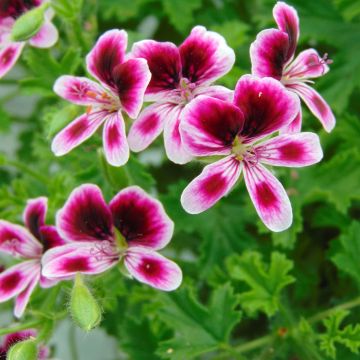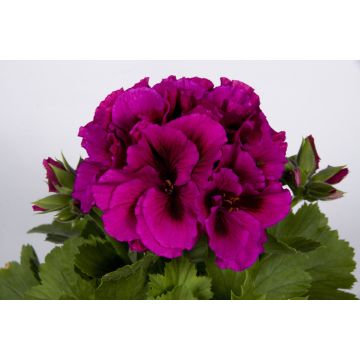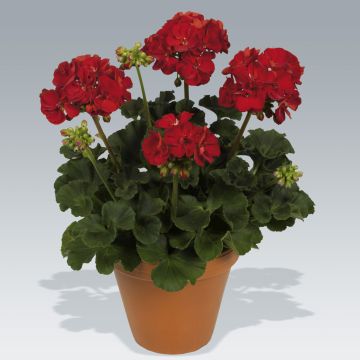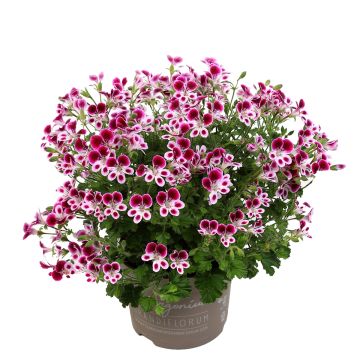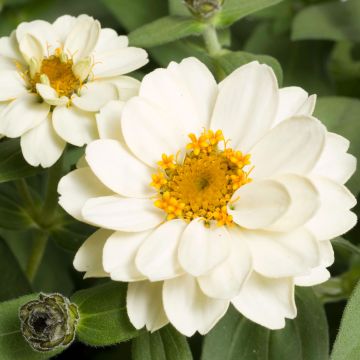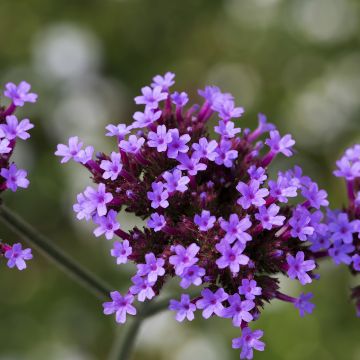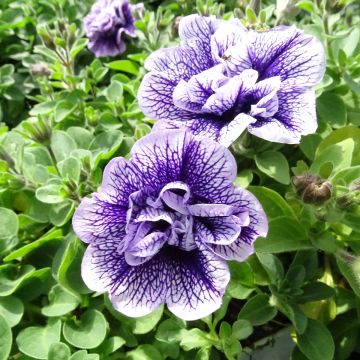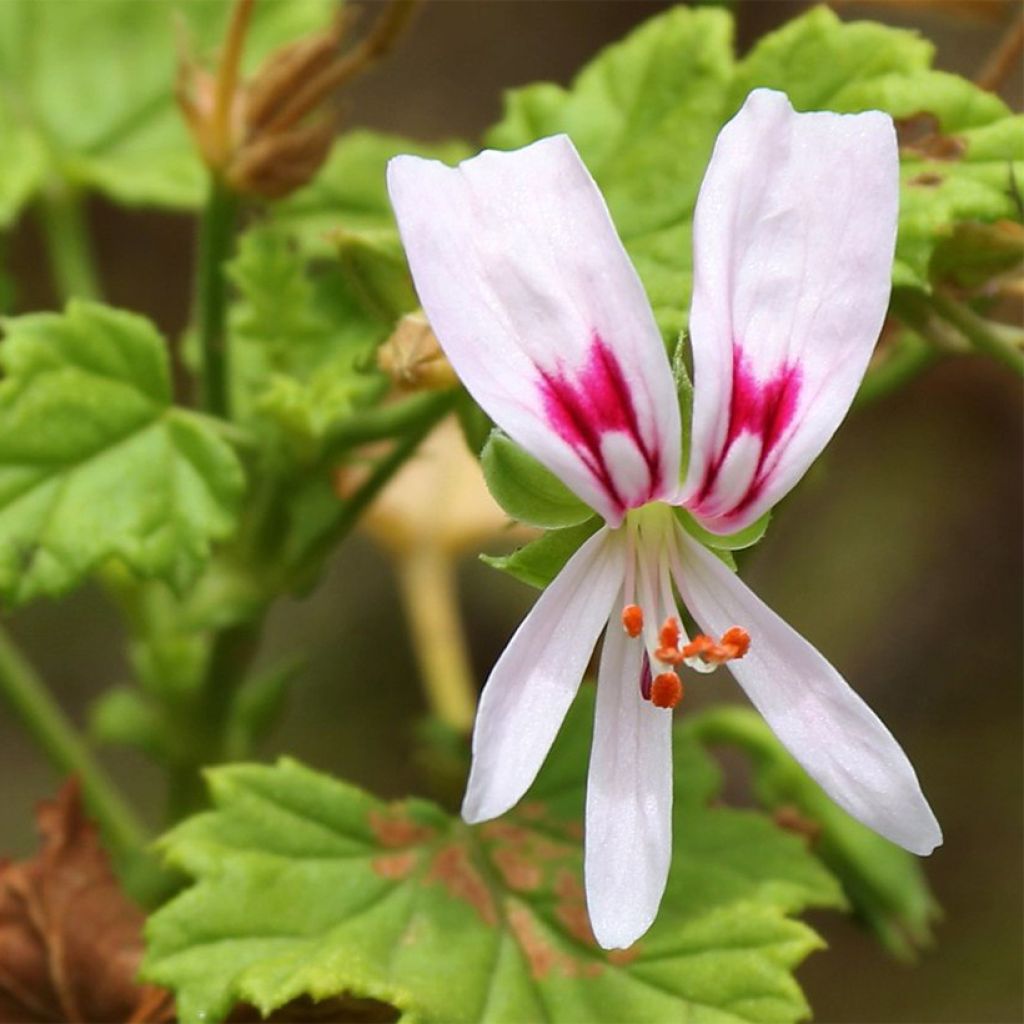

Pelargonium odorant greytonense - Géranium botanique parfum vanille
Pelargonium greytonense
Pelargonium greytonense
Greyton geranium, Greyton pelargonium
This item cannot be shipped to the selected country
Delivery charge from €5.90
More information
Schedule delivery date,
and select date in basket
This plant carries a 6 months recovery warranty
More information
We guarantee the quality of our plants for a full growing cycle, and will replace at our expense any plant that fails to recover under normal climatic and planting conditions.
From €5.90 for pickup delivery and €6.90 for home delivery
Express home delivery from €8.90.
Does this plant fit my garden?
Set up your Plantfit profile →
Description
The Pelargonium greytonense, often nicknamed the vanilla geranium, is a highly aromatic botanical species with small habit, whose foliage reveals a delicious vanilla and sweet scent. It is a small shrub wider than it is tall, which blooms heavily in late spring and more sporadically in summer. Its flowers are small, delicate, white with pink markings, grouped in small umbels. Like all Pelargoniums, this frost-sensitive species can be cultivated in pots in most climates, which allows it to be protected from the cold in winter.
The Pelargonium greytonense is a South African botanical species whose distribution area is limited to a small region in the southwest of the Western Cape. It is found on the southern slopes of the Riviersonderend Mountains, often in ravines, on acidic soils. This area experiences mainly winter rainfall, no frost, and hot and rather dry summers. This Pelargonium is a small perennial shrub belonging, like all geraniums, to the geranium family. Its bushy habit is supported by initially hairy stems, which lignify over time. They allow the plant to reach a height of about 40 cm (16in) with a spread of 50-55 cm (20-22in). Its foliage, which is evergreen in a mild winter, and ornamental, consists of palmate (hand-shaped) leaves with 3 lobes, covered with short and rather stiff hairs as well as long sparse hairs that secrete a pleasantly fragrant essential oil. Their color is a fairly light green. Their fragrance, which is released with the slightest touch, is most often perceived as sweet, very sugary, and vanilla-like. The flowering occurs from May-June to September, with a peak in the early period. It takes the form of heads consisting of 5 to 9 small flowers with 5 delicate petals, measuring 15 mm (1in), lighter and perhaps less spectacular than those of classic hybrids, whether perennial or annual, but more natural. The 2 upper petals, veined with pink-red, are larger than the 3 lower white-pink petals.
With a simple touch, the Pelargonium greytonense releases and leaves a delicate and delicious scent on the fingers. So, plant it in a pot indoors or in the ground, in a place where you can touch it: along a pathway or in a pot on the terrace, in the conservatory. We were captivated, one day after the rain, by a bed of fragrant geraniums and spent a long time immersing ourselves in a symphony of delicate aromas. It is perfectly possible to plant this frost-sensitive species in summer beds, but it will be grown as an annual.
Its leaves can be used to flavour desserts, fruit salads, ice creams. They can also be infused in milk or water. Try flavoring a recipe with the fragrant pelargonium flower, it works!
Note: Attention, our young plug plants are professional products reserved for experienced gardeners: upon receipt, transplant and store them under cover (conservatory, greenhouse, cold frame) at a temperature above 14°C (57.2°F) for a few weeks before being installed outdoors once the risk of frost is definitively passed.
Report an error about the product description
Flowering
Foliage
Plant habit
Botanical data
Pelargonium
greytonense
Geraniaceae
Greyton geranium, Greyton pelargonium
South Africa
Other Pelargonium - Geranium
Planting and care
Plant your scented geraniums and pelargoniums in the open ground after the last frost, in a sunny location. You can also plant them in a pot placed in a protected position, which you will take outside in May. Scented geraniums require well-drained soil, but not necessarily very rich soil. Water moderately. In a pot, regular watering is necessary in summer. You can protect your geraniums by bringing them indoors under a veranda or a cold greenhouse in winter. The Pelargonium greytonense is frost-sensitive, so it is essential to overwinter it frost-free in a bright, but minimally or unheated, space. You will reduce watering in winter.
Some species of pelargoniums can tolerate a light frost, but these plants will not survive the winter in the garden, except in coastal areas.
Planting period
Intended location
Care
This item has not been reviewed yet - be the first to leave a review about it.
Plug plants - Annuals
Haven't found what you were looking for?
Hardiness is the lowest winter temperature a plant can endure without suffering serious damage or even dying. However, hardiness is affected by location (a sheltered area, such as a patio), protection (winter cover) and soil type (hardiness is improved by well-drained soil).

Photo Sharing Terms & Conditions
In order to encourage gardeners to interact and share their experiences, Promesse de fleurs offers various media enabling content to be uploaded onto its Site - in particular via the ‘Photo sharing’ module.
The User agrees to refrain from:
- Posting any content that is illegal, prejudicial, insulting, racist, inciteful to hatred, revisionist, contrary to public decency, that infringes on privacy or on the privacy rights of third parties, in particular the publicity rights of persons and goods, intellectual property rights, or the right to privacy.
- Submitting content on behalf of a third party;
- Impersonate the identity of a third party and/or publish any personal information about a third party;
In general, the User undertakes to refrain from any unethical behaviour.
All Content (in particular text, comments, files, images, photos, videos, creative works, etc.), which may be subject to property or intellectual property rights, image or other private rights, shall remain the property of the User, subject to the limited rights granted by the terms of the licence granted by Promesse de fleurs as stated below. Users are at liberty to publish or not to publish such Content on the Site, notably via the ‘Photo Sharing’ facility, and accept that this Content shall be made public and freely accessible, notably on the Internet.
Users further acknowledge, undertake to have ,and guarantee that they hold all necessary rights and permissions to publish such material on the Site, in particular with regard to the legislation in force pertaining to any privacy, property, intellectual property, image, or contractual rights, or rights of any other nature. By publishing such Content on the Site, Users acknowledge accepting full liability as publishers of the Content within the meaning of the law, and grant Promesse de fleurs, free of charge, an inclusive, worldwide licence for the said Content for the entire duration of its publication, including all reproduction, representation, up/downloading, displaying, performing, transmission, and storage rights.
Users also grant permission for their name to be linked to the Content and accept that this link may not always be made available.
By engaging in posting material, Users consent to their Content becoming automatically accessible on the Internet, in particular on other sites and/or blogs and/or web pages of the Promesse de fleurs site, including in particular social pages and the Promesse de fleurs catalogue.
Users may secure the removal of entrusted content free of charge by issuing a simple request via our contact form.
The flowering period indicated on our website applies to countries and regions located in USDA zone 8 (France, the United Kingdom, Ireland, the Netherlands, etc.)
It will vary according to where you live:
- In zones 9 to 10 (Italy, Spain, Greece, etc.), flowering will occur about 2 to 4 weeks earlier.
- In zones 6 to 7 (Germany, Poland, Slovenia, and lower mountainous regions), flowering will be delayed by 2 to 3 weeks.
- In zone 5 (Central Europe, Scandinavia), blooming will be delayed by 3 to 5 weeks.
In temperate climates, pruning of spring-flowering shrubs (forsythia, spireas, etc.) should be done just after flowering.
Pruning of summer-flowering shrubs (Indian Lilac, Perovskia, etc.) can be done in winter or spring.
In cold regions as well as with frost-sensitive plants, avoid pruning too early when severe frosts may still occur.
The planting period indicated on our website applies to countries and regions located in USDA zone 8 (France, United Kingdom, Ireland, Netherlands).
It will vary according to where you live:
- In Mediterranean zones (Marseille, Madrid, Milan, etc.), autumn and winter are the best planting periods.
- In continental zones (Strasbourg, Munich, Vienna, etc.), delay planting by 2 to 3 weeks in spring and bring it forward by 2 to 4 weeks in autumn.
- In mountainous regions (the Alps, Pyrenees, Carpathians, etc.), it is best to plant in late spring (May-June) or late summer (August-September).
The harvesting period indicated on our website applies to countries and regions in USDA zone 8 (France, England, Ireland, the Netherlands).
In colder areas (Scandinavia, Poland, Austria...) fruit and vegetable harvests are likely to be delayed by 3-4 weeks.
In warmer areas (Italy, Spain, Greece, etc.), harvesting will probably take place earlier, depending on weather conditions.
The sowing periods indicated on our website apply to countries and regions within USDA Zone 8 (France, UK, Ireland, Netherlands).
In colder areas (Scandinavia, Poland, Austria...), delay any outdoor sowing by 3-4 weeks, or sow under glass.
In warmer climes (Italy, Spain, Greece, etc.), bring outdoor sowing forward by a few weeks.

































